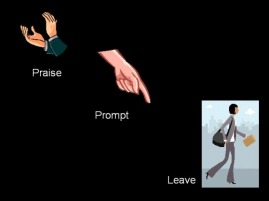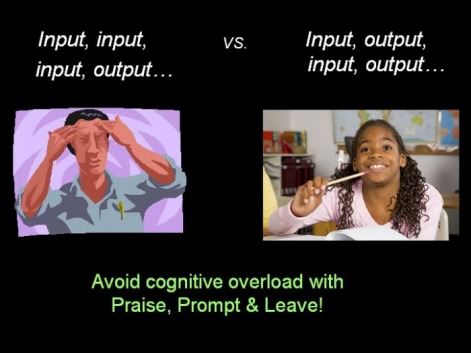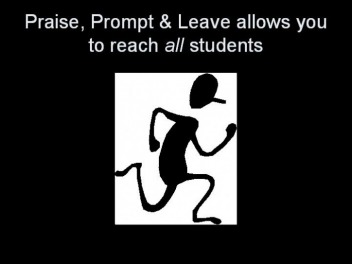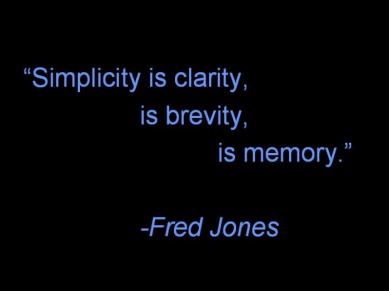Praise, Prompt & Leave

Being prepared with the basics of handling minor disruptions, it is time to introduce the method of helping students with any questions that may arise during independent practice.
Description:
In the typical classroom, guided practice is a time for many questions. The teacher is prepared to spend approximately four minutes with each. With a 20 minute block of time, it very quickly becomes apparent that the teacher is not able to reach each student. In the waiting time, there is an increased opportunity for students to misbehave. Even the students that are helped often end up with cognitive overload due to the input, input, input model looked at earlier in Say See Do teaching. However, this can be prevented through the Praise, Prompt and Leave method of question and answer. First, the teacher will take two relaxing breaths. The first is so that they can calm down and allow themselves to get in the right frame of mind. Human tendency is to look for the part that is wrong, but the Praise, Prompt and Leave teacher avoids this at all costs. The second breath, then, is used to find something on the student’s paper that is done correctly. Next, they praise the student on the portion that was correct. This should be a part that is closest to the first area of mistake or question, so that continuity is maintained. Next, prompt the student with a short sentence, “the next thing to do is....” (Jones, 2007). This teacher never uses words like but, however, or instead of, as they indicate messages of failure. After this prompt, the teacher leaves immediately. This promotes independent learners by allowing them to independently work. The prompt was clear, and they are capable to follow that through. Staying with them increases dependence on the teacher and inhibits growth as well as uses up valuable time. The entire process should be short, around 20 seconds (Jones, 2007).
Significance:
Using this method not only promotes independent learners, but ensures that ever student is reached. Also, because the teacher is moving so frequently, there is little time for students to misbehave.
Demonstration:
A first grade teacher has just used the Say, See, Do format to teach the addition of two digit numbers. During the guided practice, a student has a question. Going over to her, the teacher takes two relaxing breaths. With the first, she fights the urge to look for what is wrong. With the second, she finds something right. Noticing that the student has correctly added the ones column, the teacher uses this as an opportunity to praise. She then tells the student, “the next thing to do is add the tens column.” After stating this, the teacher turns and leaves. She will be by after a short time to ensure comprehension.
Integral Components:
Because short term memory is designed to take in small chunks of information, introducing large amounts of instruction is detrimental to students’ learning process. They can feel overwhelmed and not retain the entirety of the lesson. This is why Say, See, Do teaching is so effective. Similarly, Praise, Prompt and Leave capitalizes on the idea that, “simplicity is clarity, is brevity, is memory” (Jones, 2007). Also, without intentionally doing so, many typical teacher prompts can illicit feelings of stupidity or failure among students. By telling them in long messages, using the word, but, sighing or expressing frustration with body language, sarcasm, etc. students receive subliminal messages of failure. Praise, Prompt and Leave allows their question to be answered without this, and ensures that they are the one who is achieving the desired result. Finally, in giving directives, the teacher should use initiating requests. These are either asking someone to do something, or to do something more. They are positive and do not imply judgment. The teacher should avoid requests that ask the student to not do something in instruction (Jones, 2007).
Individualization:
Though a completely different method of helping students, I plan to use this in my own classroom. There are so many subtle messages that we as teachers send to children on a daily basis. Conveying the idea that I, as the teacher, believe they can do the task, is powerful. It shows that they can be successful and fosters independence, spurring them toward greater self-control.
Spiritual Application:
1 Thessalonians 5: 8-11 states, “But since we belong to the day, let us be self-controlled, putting on faith and love as a breastplate, and the hope of salvation as a helmet. For God did not appoint us to suffer wrath but to receive salvation through our Lord Jesus Christ. He died for us so that, whether we are awake or asleep, we may live together with him. Therefore encourage one another and build each other up, just as in fact you are doing” (NIV). In the Christian walk, we are to practice self-control and love others, encouraging them in Christ. This verse gives a clear indication of that. Therefore, if this is the model for a Christ-follower, it can also be used as a teacher. Because we are modeling the Christian life to students, exhibiting these characteristics is vital. By exercising self-control and practicing encouragement, students not only receive these messages, but are able to apply them as well.



